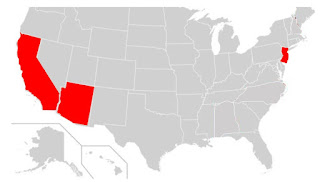With New Hampshire finally determining how to draw the lines between its two congressional districts, all states have now completed redistricting for the 2022 elections (six states only have one U.S. House seat, so redistricting is irrelevant there).
The Redistricting Compendium
This website collects articles published on the U.S. House redistricting heading into 2022. For incisive analysis of population shifts and possible new district lines, see Dave Wasserman!
Tuesday, June 7, 2022
Redistricting Now Complete in All States (NATIONAL)
Friday, February 4, 2022
Politico (2/4/22) on Court Challenges to Redistricting Maps Around the Country (NATIONAL)
Politico provides an overview of the states in which legislatively enacted redistricting maps have been challenged in state and federal courts. In some states (such as Ohio and Pennsylvania), courts have already ruled, whereas in others (e.g., Florida), the cases are pending.
UPDATE: In a ruling released roughly within the past hour, the North Carolina Supreme Court has struck down that state's redistricting map. Like rulings in other states, the one in North Carolina should help the Democrats.
Monday, January 31, 2022
Five-Thirty-Eight (1/31/22) on Potential U.S. House Districts for New York State
Friday, January 14, 2022
Five-Thirty-Eight (1/14/22) on Ohio Supreme Court's Rejection of GOP Redistricting Map (OHIO)
Nathaniel Rakich at Five-Thirty-Eight examines the Ohio Supreme Court's rejection of the congressional map passed by the state's Republican-majority legislature and the decision's possible implications for the partisan makeup of the state's future U.S. House delegation (LINK). Rakich also looks at which other states have thus far passed highly partisan maps (by statistical indicators) that may be vulnerable to court challenges.
Sunday, December 26, 2021
Wasserman on Twitter (12/22/21): Redistricting "Close to a Wash" (NATIONAL)
Redistricting expert Dave Wasserman released the following tweet a few days ago. It is much better news for Democrats than would have been expected at the beginning of the redistricting cycle. Wasserman still considers the Republicans heavy favorites to take the US House majority, but this prediction is based on President Biden's current low job approval, not on redistricting...
Friday, December 24, 2021
Politico on California (12/21/21), Arizona (12/22/21), and New Jersey (12/22/21)
Three recent articles from Politico detail the new maps in three states. You can click on the names of the states to access the full articles. Below are some key quotes from these articles, with my occasional comments (in purple) to add context.
Thursday, December 2, 2021
Five-Thirty-Eight (12/2/21) on How Redistricting Looks So Far (NATIONAL)
Five-Thirty-Eight evaluates the partisan implications of the redistricting that has taken place so far (in 18 states). Three key points stand out to me.
...Democrats might be OK with that tradeoff, as any election that results in the loss of slightly Democratic-leaning seats is probably an election in which Republicans have already won the House handily. Instead, the goal of these new maps in Illinois, Nevada and Oregon seems to be to maximize the number of Democratic wins in neutral political environments, when the House is genuinely competitive.
Redistricting Now Complete in All States (NATIONAL)
With New Hampshire finally determining how to draw the lines between its two congressional districts, all states have now completed redis...

-
New Mexico political blogger Joe Monahan (h/t Dave Wasserman) reports on a map under consideration (appearing to the left) that would likely...
-
Over at The Atlantic , Dave Wasserman writes about a shift in how most members of the Congressional Black Caucus (CBC) from southern states...
-
Two nice articles -- one from The Oregonian and the other from The Hill -- on Oregon becoming the first state of this redistricting cycl...










